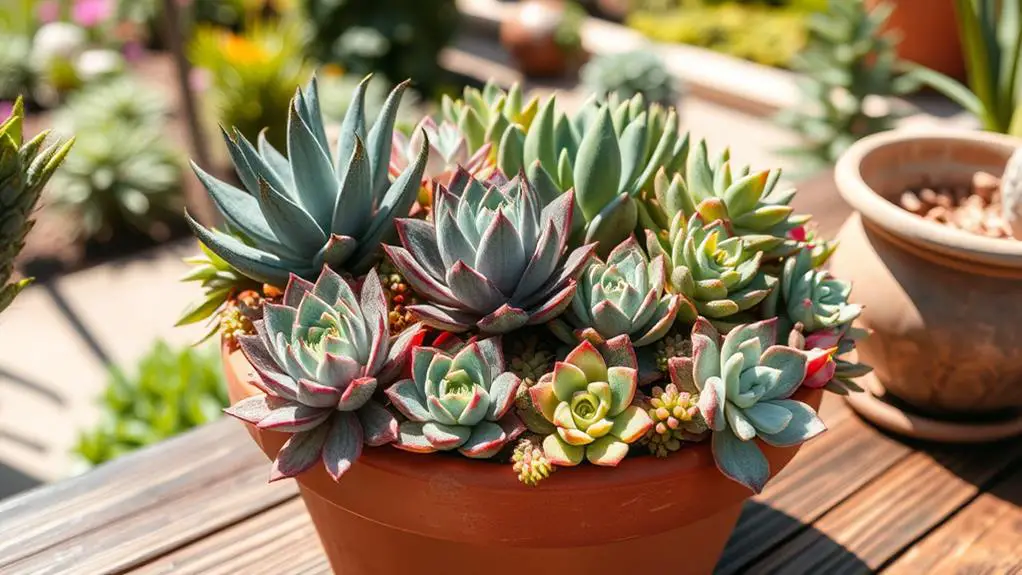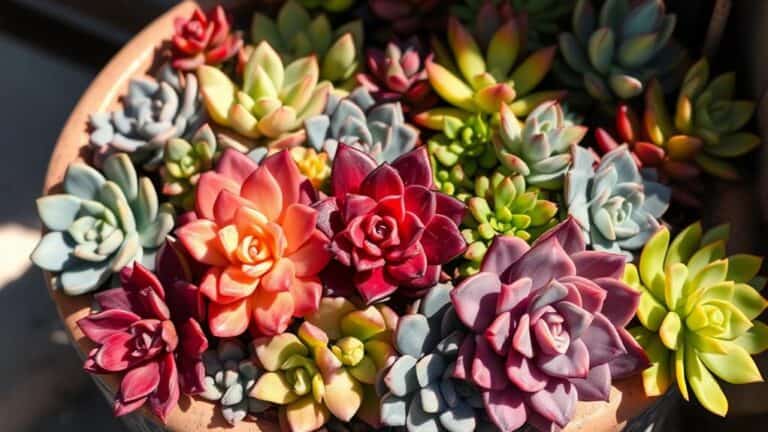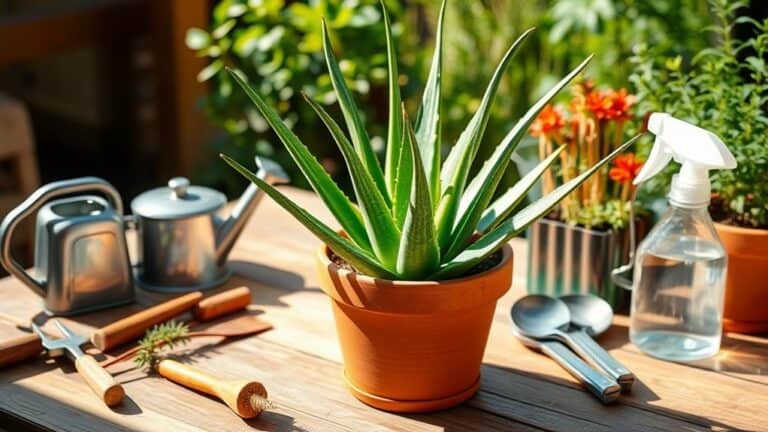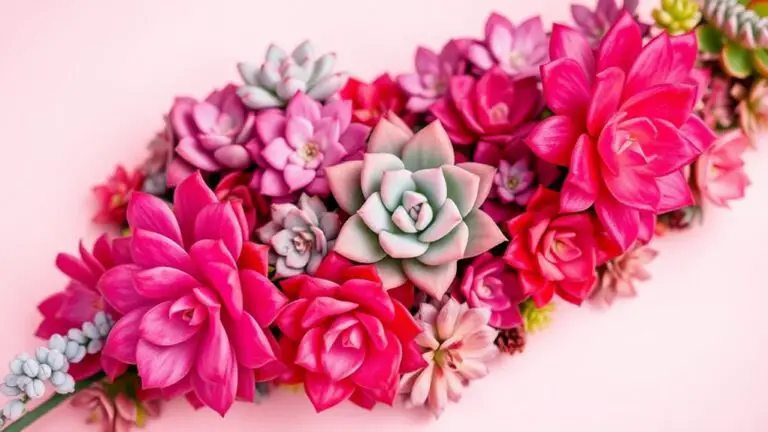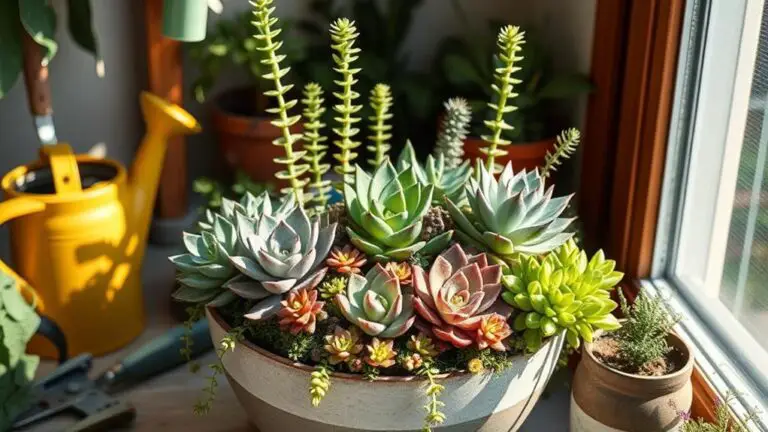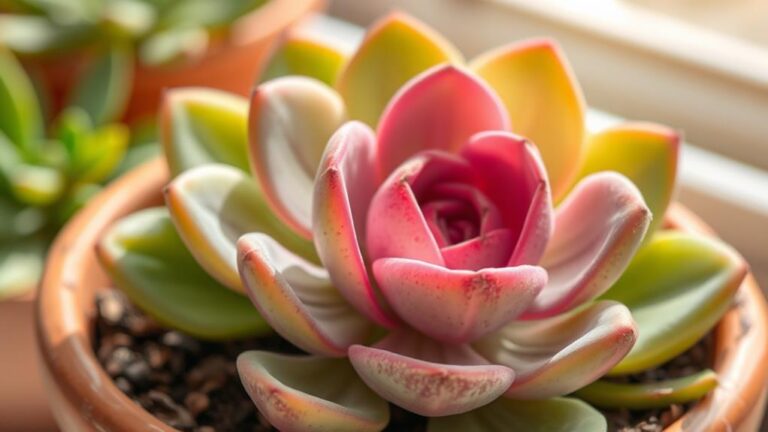9 Tips on Which Succulents Can Be Planted Together
When deciding which succulents to plant together, you'll need to contemplate several factors to guarantee they thrive in harmony. Start by evaluating their light requirements; pairing succulents with similar sunlight needs prevents one from overshadowing another. Next, think about water needs—some succulents prefer more moisture, while others thrive in drier conditions. By grouping those with matching requirements, you maintain a balanced environment. But that's just the beginning. The interplay of colors, shapes, and textures can transform your garden into a visually stunning masterpiece. Curious about the best combinations and techniques? There's more to uncover.
Light Requirements
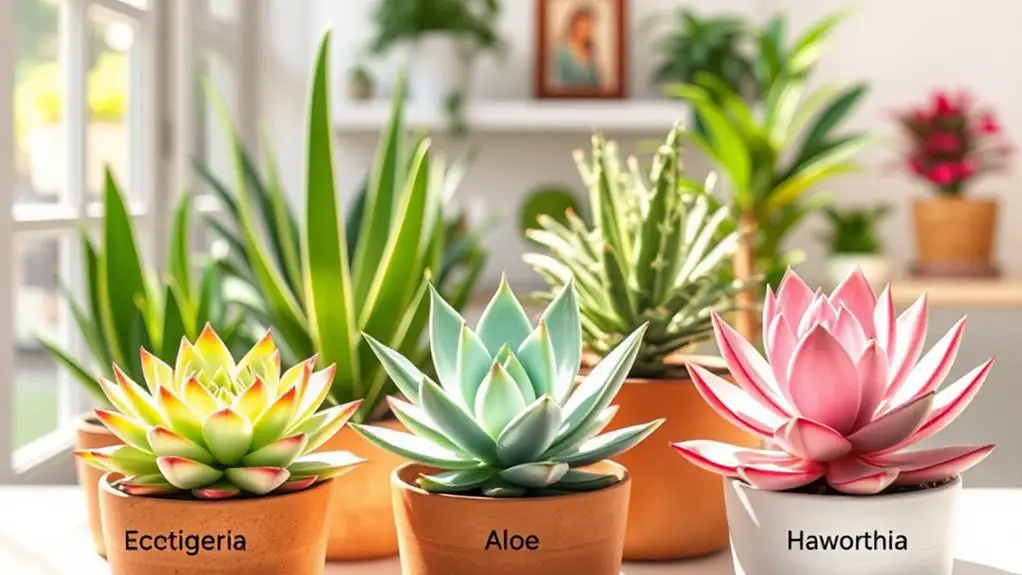
Understanding the light requirements of your succulents is essential for their health and growth. Most succulents thrive with bright morning sun followed by bright shade in the afternoon. This means you need to carefully consider their light needs when planting succulents together.
Some varieties, like Echeveria and Sedum, love full sun exposure all day. Others, such as Aloe and Haworthia, prefer partial shade to avoid sunburn.
Mixing succulents with varying light needs can be tricky. If you plant sun-loving succulents next to those that prefer shade, you might see stretching or sunburn. This can harm the health and look of your plants.
It's important to group succulents that have similar light preferences to keep them happy and growing well.
Water Needs
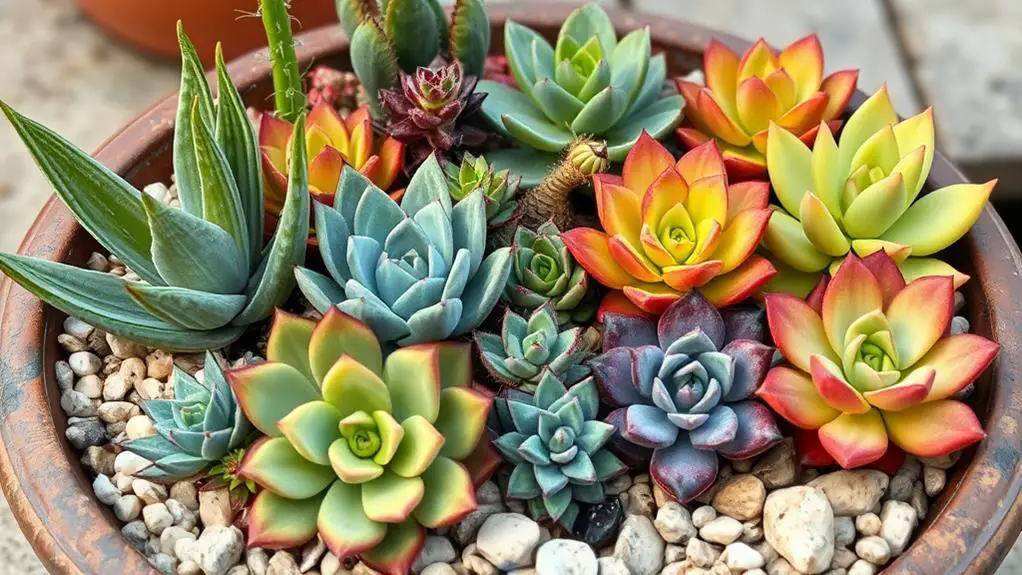
While light requirements are key to succulent health, their water needs are equally important. Understanding these needs will help you grow a thriving collection. Succulents with thicker leaves, like Echeveria and Haworthia, need less frequent watering. Thinner-leaved varieties, such as Portulacaria afra and Rhipsalis cereuscula, require more regular moisture.
To keep your succulents happy, let the soil dry completely between watering sessions. Overwatering can lead to root rot, which is a common problem. Grouping succulents with similar water needs together is a smart move. For example, cacti and Echeverias both prefer drier conditions, reducing the risk of overwatering.
Sometimes, you might need to spot water. This means giving specific plants more or less water based on their needs. Thinner-leaved succulents often need this extra attention. Understanding these water preferences is essential. While cacti can go longer without water, some tropical succulents like more frequent hydration.
Here's a handy table to help you remember:
| Succulent Type | Water Needs |
|---|---|
| Thicker-leaved (Echeveria, Haworthia) | Less frequent watering |
| Thinner-leaved (Portulacaria afra, Rhipsalis cereuscula) | More regular moisture |
| Cacti | Extended intervals |
| Tropical Succulents | More frequent hydration |
Color Combinations
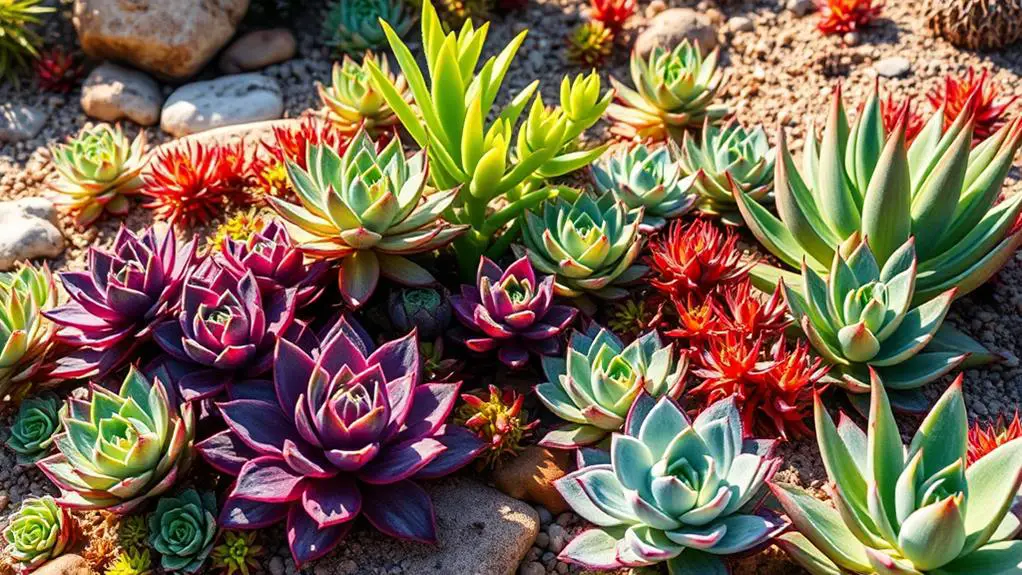
When you're planning your succulent garden, think about using different color schemes to make your arrangement pop.
You can try complementary colors, like red and green, or go for a monochromatic look with various shades of one color.
Analogous color palettes, like yellow, yellow-green, and green, can also create a soothing and harmonious display.
Enhancing Visual Appeal
Creating visually stunning succulent arrangements is all about mastering color combinations. First, consider using complementary colors. Pairing red succulents with green varieties creates a striking contrast that makes your arrangement pop. This bold approach can transform a simple display into an eye-catching masterpiece.
Another great option is a monochromatic arrangement. By using different shades of the same color, like various greens or pinks, you can add depth and sophistication to your succulent display. This method creates a unified look that's both elegant and intriguing.
If you prefer a more harmonious look, try an analogous color scheme. Grouping succulents in colors that are next to each other on the color wheel—like yellow, yellow-green, and green—provides a cohesive and visually pleasing arrangement. This technique can make your succulents look naturally grouped and serene.
Don't forget the impact of pot colors. Bright or contrasting pots can highlight the succulents' natural hues, making the overall display even more appealing.
Monochromatic Schemes
After mastering color combinations for visually appealing succulent arrangements, let's explore the beauty of monochromatic schemes. These schemes involve using succulents of the same color but in different shades. This approach creates a cohesive and visually striking display that's both simple and elegant.
For example, you can combine various shades of green succulents, like Echeveria and Haworthia. This mix adds depth and interest while maintaining a unified appearance.
Adding succulents with similar textures can enhance the monochromatic effect. Think about the smooth, glossy leaves of Graptopetalum paired with the thicker, fleshy leaves of Jade plants. This combination not only looks great but also keeps the focus on the plants' unique shapes and textures.
Choosing a single pot color that complements your succulent shades can further unify your arrangement. A well-chosen pot can elevate the entire aesthetic, making your monochromatic design even more appealing.
Monochromatic schemes are also effective in highlighting specific features of your succulents, like their leaf shapes or patterns, without the distraction of contrasting colors.
Analogous Color Palettes
Analogous color palettes offer a delightful way to create succulent arrangements that flow seamlessly from one hue to the next. By selecting succulents that are adjacent on the color wheel, you can achieve a harmonious look that enhances your garden's aesthetic without overwhelming the viewer.
For example, pairing yellow, yellow-green, and green succulents can create a cohesive arrangement.
When creating succulent arrangements with analogous color palettes, follow these steps:
- Choose Complementary Succulents: Combine varieties like Echeveria 'Lola' (pink), Echeveria 'Perle von Nurnberg' (lavender), and Graptopetalum paraguayense (white) for a soft gradient effect.
- Incorporate Varied Textures: Use the smooth leaves of Aloe alongside the spiky form of Agave to add visual interest while maintaining color harmony.
- Consider Seasonal Changes: Pay attention to how colors may shift with environmental factors to guarantee a pleasing display year-round.
Planting Techniques

When it comes to planting techniques for succulents, grouping plants with similar growth requirements is crucial for their well-being.
Start by considering each succulent's light and water needs so they can thrive together without stress. A great technique to use is the thriller-filler-spiller arrangement. In this setup, taller succulents act as focal points (thrillers), shorter ones fill gaps (fillers), and trailing plants cascade over the edges (spillers).
Layering plants based on height can create visual interest. Place taller succulents in the back or center and shorter ones around the edges. This not only looks good but also guarantees that all plants get enough light.
Choose pots with proper drainage to prevent root rot. Materials like terracotta are excellent because they allow for airflow and moisture control. Make sure your pots have drainage holes to let excess water escape.
Regularly prune and maintain your mixed arrangements. This promotes healthy growth and prevents overcrowding, guaranteeing each plant gets the resources it needs.
With these planting techniques, you'll have a beautiful, thriving succulent arrangement that's easy to care for. Happy growing!
Growth Compatibility

Ensuring growth compatibility among your succulents is key to cultivating a healthy and harmonious arrangement. When selecting succulents to plant together, it's essential to match species with similar growth requirements. This means taking into account their light and water needs to prevent stress and promote ideal health.
Grouping succulents by their dormancy periods is a smart move. For instance, winter-dormant varieties like Echeveria and Sempervivum thrive together, while summer-dormant types such as Aeonium and Aloe co-exist perfectly. This way, their growth cycles remain in sync, ensuring harmonious development.
Another factor to bear in mind is the hardiness of your succulents. Hardy succulents, which can withstand frost, should be paired with other hardy varieties. This prevents tender succulents from suffering damage in cold temperatures.
To help you further, here's a handy list:
- Match Growth Requirements: Pair succulents with similar light and water needs.
- Take into Account Dormancy Cycles: Group winter-dormant and summer-dormant succulents separately.
- Assess Watering Frequency: Thicker-leaved succulents need less frequent watering than thinner-leaved ones.
Soil and Drainage
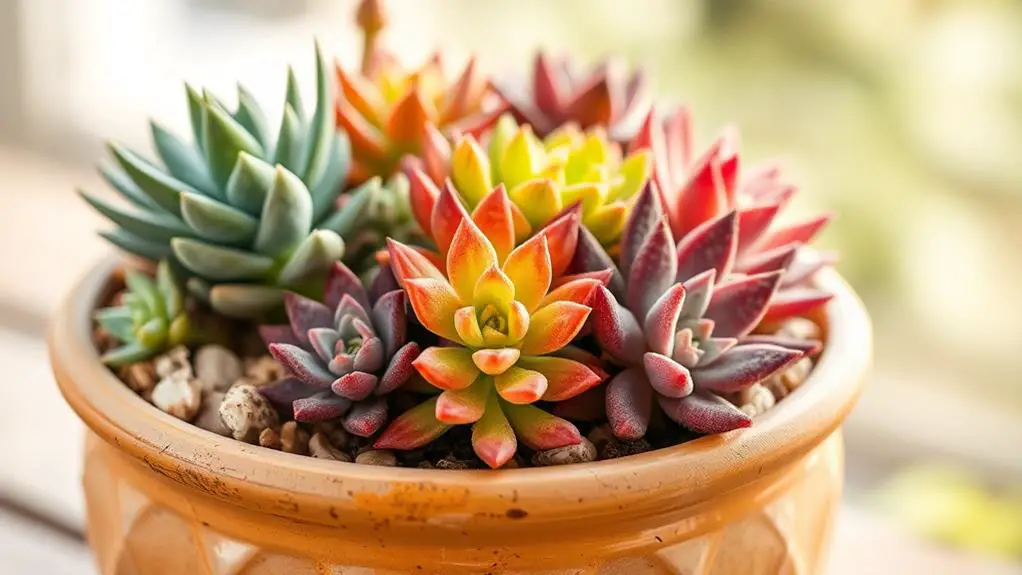
For your succulents to thrive, using well-draining soil is key.
Consider a cactus mix or a blend of regular potting soil with sand to keep their roots healthy.
Make sure your pots have drainage holes and regularly check soil moisture, letting it dry out completely between waterings.
Well-Draining Soil Importance
Well-draining soil is a game-changer for succulents, as it prevents water retention that can lead to root rot and other moisture-related problems.
To keep your succulents healthy, you must understand the importance of well-draining soil and how it impacts plant health.
First, you need to choose the right soil mix. A cactus mix or sandy soil is ideal because it guarantees proper drainage and aeration around the roots.
This kind of soil lets water pass through quickly, preventing it from sitting around and causing root damage.
Second, consider adding a layer of gravel or pumice on top of the soil. This extra layer enhances drainage, preventing water from pooling at the base of the pot.
It's a simple step that makes a big difference in keeping your succulents happy.
Third, always use pots with drainage holes. These holes allow any excess water to escape, which is vital for maintaining a healthy root system.
Without them, water can stay trapped, leading to potential problems.
Key Points:
- Use cactus mix or sandy soil for proper drainage.
- Add gravel or pumice to enhance soil drainage.
- Choose pots with drainage holes to prevent water retention.
Optimal Pot Drainage
It's not just the soil mix that matters; the pot you choose plays a significant role in keeping your succulents thriving. Ideal pot drainage is essential for their health. Always use containers with drainage holes to prevent standing water, which can cause root rot. Your succulents need well-draining soil, like a cactus mix or sandy soil, to avoid retaining too much moisture.
Adding a thick layer of gravel or pumice at the bottom of the pot can really help with drainage and root aeration. For an even better setup, create a 50/50 mix of cactus potting mix and regular potting mix. This blend is perfect if you're planting succulents alongside other types of plants.
Here's a simple guide to help you get started:
| Tip | Why It Matters |
|---|---|
| Use pots with drainage holes | Prevents standing water and rot |
| Choose well-draining soil | Avoids excess moisture retention |
| Add gravel or pumice | Enhances drainage and aeration |
| Mix cactus and regular potting soil | Balances moisture and nutrients |
| Check moisture levels regularly | Guarantees soil dries out properly |
Moisture Level Monitoring
Monitoring moisture levels is essential for the health of your succulents. The key to keeping these plants happy is ensuring the soil dries out completely between waterings. Over-watering can lead to root rot, a common issue with succulents.
Here are some tips to help you get it right:
- Use well-draining soil: A cactus mix or adding sand and gravel to regular potting soil can improve drainage. Well-draining soil prevents water from sitting around the roots, which succulents dislike.
- Choose pots with drainage holes: Always use pots with drainage holes to let excess water escape. This reduces the risk of over-saturation, ensuring your succulents get the right amount of moisture.
- Follow the "soak and dry" watering method: Water your succulents until the soil is thoroughly soaked, then let it dry out completely before watering again. This method helps maintain ideal moisture levels and mimics the natural environment of succulents.
Shape and Texture

Crafting a visually stunning succulent arrangement hinges on thoughtfully considering shape and texture. By combining succulents with varied shapes, like tall Echeveria alongside trailing Senecio, you can create dynamic visual contrasts that grab the eye.
Texture plays a vital role too. Textured succulents such as Gasteria and Aloe add depth and interest, enhancing the overall aesthetic of your mixed plantings.
When selecting succulents, think about how different shapes and textures work together. For instance, mixing spiky cacti with softer, round succulents creates a striking juxtaposition. This contrast not only draws attention but also highlights each plant's unique characteristics.
If you prefer a more cohesive look, consider clustering round-shaped succulents like Haworthia. The uniform shape provides a harmonious feel, while the varying textures keep the arrangement engaging.
Layering succulents of differing heights is another effective technique. Taller varieties can serve as focal points, with shorter ones filling in around them to add dimension and structure.
This layering adds depth and guarantees your arrangement looks balanced and well-planned. By thoughtfully combining shape, texture, and heights, you'll create a beautiful and enchanting succulent display.
Container Selection
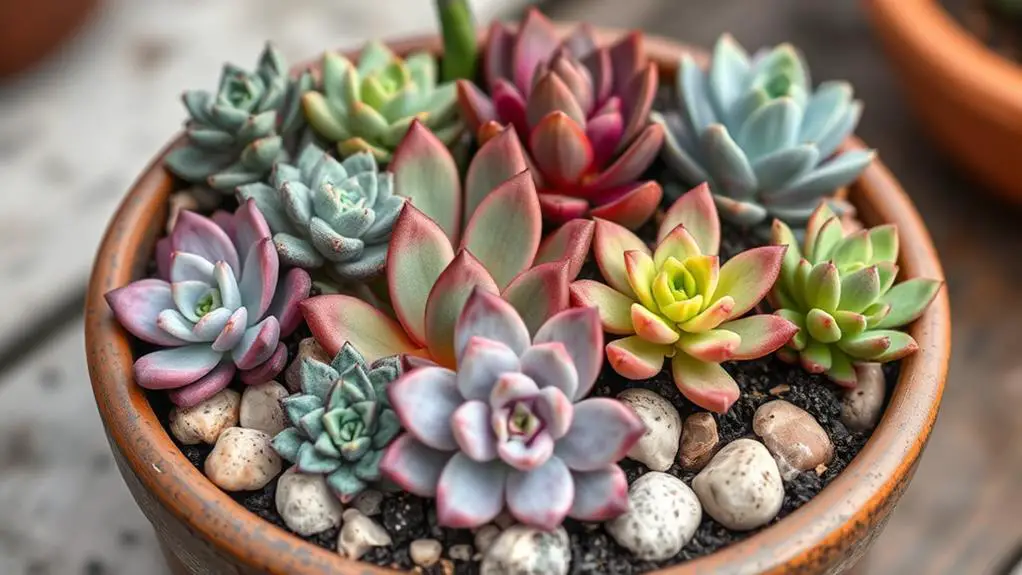
When selecting containers for your succulents, focus on functionality and aesthetics. The right container selection can make a big difference in the health and appearance of your plants. Here are some key points to reflect upon:
- Drainage Holes: Always choose pots with drainage holes. These holes let excess water escape, preventing root rot and keeping your succulents healthy. Without them, water can accumulate at the bottom, which is harmful to these drought-tolerant plants.
- Breathable Materials: Opt for containers made from breathable materials like terracotta or clay. These materials allow moisture to evaporate more effectively than plastic containers, helping to keep your succulents' roots dry and aerated. Terracotta also adds a rustic charm to your garden.
- Size and Space: Make sure the container size is appropriate for your succulents. Avoid overly large pots, as they can hold too much moisture, leading to plant stress. Each succulent should have enough space for its roots to grow comfortably without being cramped.
Additionally, reflect upon the color and texture of your pots. Bright, contrasting colors can make your succulents pop, while monochromatic pots offer a more cohesive look.
Decorative elements like pebbles on top of the soil can enhance both function and beauty.
Ideal Plant Combinations
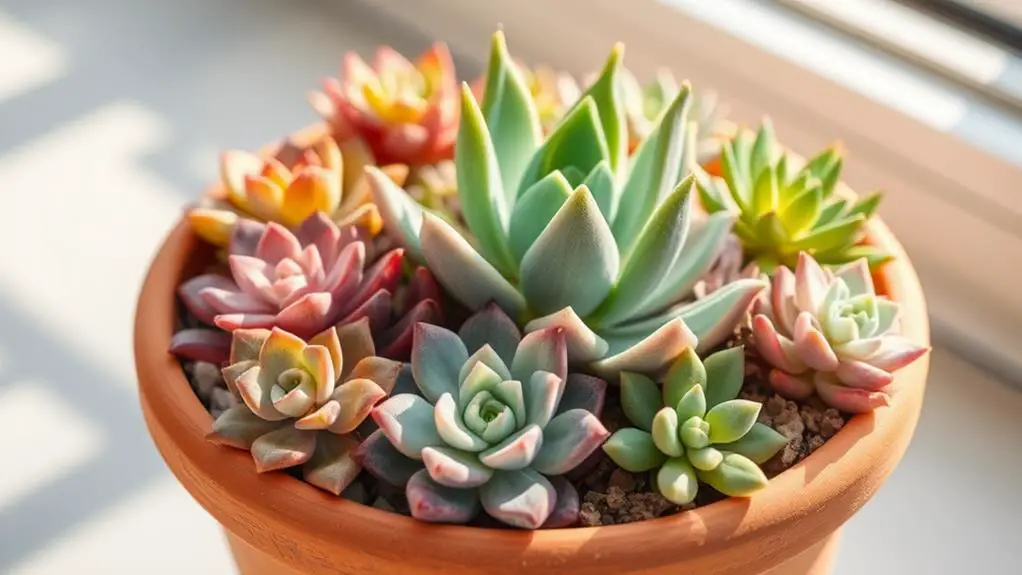
Wondering how to create a visually stunning and thriving succulent arrangement? Start by pairing succulents with similar water and light needs. For example, Echeveria and Sedum both love bright light and need less water, making them ideal plant combinations for your succulent arrangements. This guarantees your plants will thrive together without conflicting care needs.
Next, consider the dormancy periods of your succulents. Summer-dormant varieties like Aeonium and Kalanchoe can be planted together, while winter-dormant types such as Agave and Sempervivum should be grouped separately. This prevents care conflicts and keeps your arrangement healthy year-round.
Mixing different shapes and textures also adds visual interest. Use a tall Sansevieria as a "thriller," Echeveria as a "filler," and trailing Sedum as a "spiller." This combination not only looks beautiful but also meets each plant's care needs.
Additionally, group hardy succulents like Sempervivum, which can tolerate frost, with other varieties that can withstand similar conditions. This guarantees all plants in your arrangement will thrive together.
Frequently Asked Questions
How Do You Know What Succulents Can Be Planted Together?
You can determine which succulents can be planted together by comparing their light, water, and temperature needs. Make certain they have similar growing periods and choose visually complementary plants for a harmonious and healthy arrangement.
What Succulents Can You Put Together?
You can pair Echeveria with Sedum for full sun, Aloe with similar low-water succulents, and mix heights like Sansevieria with Echeveria. Confirm their light, water needs, and dormancy periods align to keep them thriving.
What Succulents Should You Not Plant Together?
You shouldn't plant winter dormant succulents like Echeveria with summer dormant ones like Aeonium. Avoid combining succulents with different light, water, soil, or temperature needs to prevent stress and guarantee healthy growth for all plants.
Which Succulents Can Be Grafted Together?
You can graft succulents like Echeveria and Graptopetalum together since they're closely related. Pair cacti like Echinopsis with Gymnocalycium for similar success. Guarantee clean cuts and proper healing conditions to prevent tissue rejection and achieve vigorous growth.
Conclusion
By following these tips, you'll create a beautiful and healthy succulent arrangement. Remember to group plants with similar light and water needs, and mix different shapes and textures for visual interest. Don't forget to take into account frost tolerance and seasonal dormancy. With the right care and attention, your succulent garden will thrive. So, get planting and enjoy the process—you're well on your way to becoming a confident succulent gardener!

